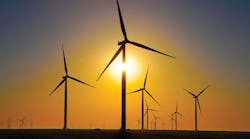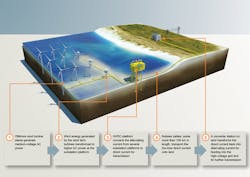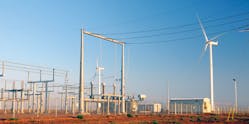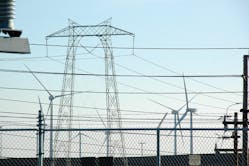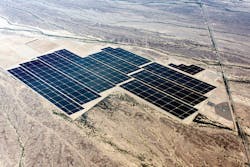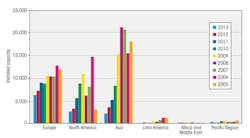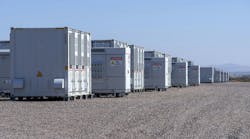Infrastructure is not sexy. This is just one of those facts of life that will not change. It is made to become invisible, blend in and disappear. Think about it, after their completion, cell phone towers, rooftop solar and transmission lines quickly become part of the background. It’s just too bad no one notices this underlying framework that is so necessary to the operation of society. If people were more aware of it, it might be easier to add to it, such as adding transmission infrastructure for connecting renewables to the grid.
In the last decade, worldwide renewable generation has exploded onto the grid with exponential growth, but the transmission infrastructure has lagged behind. On one hand, there has been a great deal of effort to encourage the growth of this resource. There have been tax credits, low interest rates and preferential regulations, and these have worked. On the other hand, there has been very little in the way of incentives for transmission. It’s no wonder there are times when grid operators have to dump energy produced by wind turbines on windy days because regional power systems cannot handle it. Therein lies the problem.
Several factors are at work here. One factor is the old real estate mantra — location, location, location. Some of the best locations for wind are extremely remote. In some cases, this remoteness may be many miles from the closest transmission. If a line is nearby, chances are it was built to bring power to the rural area. It was never sized to carry large amounts of power out of the area.
There is also the issue of how quickly a wind farm or group of wind farms can be constructed, as opposed to how long it takes to build a transmission line. While a mega wind farm typically can be designed, built and commissioned in less than a year, a transmission line project has to follow regulations and procedures that were developed in the 20th century, for the most part, and that can take 10 years for the same process.
Catch-22
The solution appears to be simple: build more transmission lines. But is it that simple? Traditionally, new transmission lines cannot be built unless there is a proven need for them. To prove that need, there is usually a signed interconnection agreement, but wind farms make it a little more complicated. The wind farm cannot be built without transmission, and a utility cannot build transmission without the wind farm. It is the classic Catch-22 scenario.
This does not mean utilities are not adding new transmission infrastructure to the global grid for all of this renewable generation; they are, but it is not happening fast enough to avoid problems. One example of the industry’s commitment to building transmission is the latest report from the Edison Electric Institute (EEI). In its “Transmission Projects: At a Glance” report for 2014, EEI states member utilities are planning on spending approximately US$46 billion on projects supporting the integration of renewable resources into their transmission systems. That figure represents 76% of the approximately $60.6 billion budget members are anticipating expending in the next 10 years.
For the actual construction figures in 2013, look at the Federal Energy Regulatory Commission’s (FERC’s) “2013 Energy Infrastructure Update.” This update is a snapshot of the entire energy industry for the year. One section details what happened in regards to transmission. In 2013, FERC reported an increase of 3,295 miles (6,317 km) of transmission lines. It also projected the addition of 12,980 miles (20,889 km) by the end of 2015 based on filings, but FERC is doubtful that much will be built. With normal delays and such, FERC said it was more likely the number would be reduced to about 4,500 miles (7,242 km) of completed transmission.
It would be great if all 12,980 miles of new transmission were built in the next year and a half, but FERC is probably correct in its assessment. It would be even better if a lot more than that amount was actually built, but building new power lines is a complicated process. It seems, too, the bigger the project, the more chance of something happening to slow it down. That is why it is so exciting that a new trend has been quietly taking place in the industry.
More Than Wire
About three years ago, NV Energy and Great Basin Transmission South generated a lot of interest in the renewables community. They took on the task of connecting the northern and southern sections of Nevada with a 500-kV transmission line (see T&D World, “NV Energy Delivers Renewable Energy,” May 2014). This area has a great deal of renewable energy potential, and it is very remote from the load centers and the established transmission facilities in the state.
By building a 500-kV transmission line across this area, not only was 800 MW of transmission capacity added, but the two sections of the state were connected to a more reliable power supply. It also will open up the wind and solar potential of remote areas in Nevada with the load centers throughout the West.
Another innovative approach to this wind versus transmission conundrum is taking place in Southern California Edison’s (SCE’s) service territory. The Tehachapi Renewable Transmission Project is being developed to tap into the vast resources available here. The Tehachapi region of Southern California has been a hotbed of wind farm since the early 1980s.
Wind by Wire
This unique geographical region around the Tehachapi Mountains is one of the windiest places in the world, with prevailing northwesterly winds blowing almost continuously between 14 mph and 20 mph (23 kmph and 32 kmph). As a result, wind developers have been crawling all over each other to stake a claim in this rich region. It is estimated that over a dozen private companies have installed more than 5,000 wind turbines in this area. The Center for Energy Efficiency and Renewable Technologies reported there are more than 6,000 MW of wind in the planning stages for the Tehachapi region. This area is a significant source of green power for Southern California.
In the early 2000s, SCE recognized there was a growing transmission problem to access this remote renewable-rich resource area. SCE started the planning process for the Tehachapi Renewable Transmission Project in 2004. It covers the entire Tehachapi region and consists of more than 250 miles (402 km) of new and upgraded high-voltage transmission facilities. Construction began in 2009 and is expected to be completed sometime in 2015. The completed transmission project is designed to carry about 4,500 MW of clean, green power to consumers in SCE’s service territory.
The California Public Utility Commission (PUC) recently started requiring its utilities to install storage systems on their systems to improve renewable generation quality. Working with the U.S. Department of Energy, the California PUC and A123 Systems, SCE decided the Tehachapi project would be an excellent testing ground for adding this storage element. It will consist of an 8-MW, 4-hour lithium-ion battery with a smart inverter system, and the goal will be to determine how much this device improves the output of these renewable resources.
A Different Way of Thinking
Some visionary utilities and independent system operators, along with the help of sensible regulators, have taken a totally different approach to the need for adding infrastructure to the grid. They realized building new transmission facilities for one project at a time will never allow utilities to get ahead of the flood of renewable projects. These farsighted organizations are taking a more holistic approach to the issues. By taking a global view of the situation at hand, they can be proactive rather than reactive. Perhaps the most ambitious of all these perceptive stratagems to get more wire in the air started almost 10 years ago.
Members of the Electric Reliability Council of Texas (ERCOT) started planning an enormous strategy shift in the early 2000s. They called it the Texas Competitive Renewable Energy Zone (CREZ) transmission project. CREZ includes roughly 3,600 miles (5,794 km) of high-voltage transmission lines stretching from the windy Texas Panhandle and West Texas areas to urban centers such as Dallas, Fort Worth, Waco and Austin. After many years of planning, the Texas PUC approved the project in 2008.
All that work is wrapping up in 2014 with the completion of the project. Nearly $7 billion has been spent on the CREZ project, which will move 18,500 MW of wind power across the state. Texas is taking integration of the wind seriously. By the end of 2013, it had about 12,355 MW of wind generation installed, but it does not stop there. The Texas PUC reports there are roughly 8,000 MW of new projects in development and more than 26,700 MW under study.
These additions are already bearing fruit. ERCOT reported its transmission system additions have allowed it to take advantage of wind resources in a big way. On March 26, 2014, wind generation reached a new record of 10,296 MW, which was 29% of the 35,768 MW being used on the ERCOT grid that day. CREZ additions provided ERCOT with 8,863 MW from West Texas and the Panhandle. The rest was supplied from the Gulf Coast wind facilities. With results like this, it is no wonder many other jurisdictions are watching the outcome of this new approach to integrating wind and solar to the grid.
Using Technologies
Not only is it important to develop new strategies like the Texas CREZ, but utilities need to take advantage of all the technologies available. One of the most promising is high-voltage direct-current (HVDC) transmission. It has been used effectively in several areas of the world, but in Europe, ABB, Alstom and Siemens report HVDC is being adapted to offshore wind farm applications at a staggering rate. They point out that the European Union’s offshore grid project outlines a plan for an HVDC grid system connecting North Sea and Baltic Sea wind farms to the continent. It uses a series of HVDC hubs connected at sea (see T&D World, “HVDC Transforming an Industry,” April 2012), bringing the power to land through HVDC marine cables.
Point-to-point HVDC transmission systems also have been very successful worldwide with operational transmission facilities in South America, Africa, Australia, Europe, India, North America and China. In North America and Europe, HVDC is being driven by renewable energy. China and India are being driven by their rapidly expanding economy, but renewables are playing an important role there, too, as these regions work to reduce their carbon footprints, bringing remote hydro generation to load centers.
This technology offers system operators direct control of energy flows independent of unrelated ac system outages. HVDC also improves the bottom line for transmission providers with the transfer of larger amounts of power at lower losses. The typical 600-mile (966-km)-long 735-kV ac line has about 6.7% of losses with a transfer capacity of roughly 3 GW. An 800-kV dc line of the same length has approximately 3.5% losses and is able to transfer more than 6 GW.
Navigant Research estimates more than 100 new HVDC transmission line projects with a capacity of approximately 333 GW — with nearly 200 GW in China alone — will be constructed worldwide from 2013 through 2020. The company reported, “Growth in electricity demand, transmission system congestion and grid instability are all helping drive new demand for HVDC transmission systems.”
These advantages have not been missed by the many merchant companies. As a result, merchant companies are proposing many HVDC transmission projects worldwide for carrying renewable power generated remotely to far off urban load centers.
One of the most large-scale approaches comes from Clean Line Energy Partners, which has five HVDC projects either proposed or under development. These projects are all point-to-point and some propose the multi-terminal approach to take advantage of HVDC’s unique ability to place power exactly where it is wanted.
Each of the projects is designed to connect approximately 3,500 MW of wind generation using a HVDC transmission line of many hundreds of miles. They stretch from the plains and deserts in the center of the country to load centers on the East and West Coasts of the continent. Clean Line Energy Partners has formed alliances with manufacturers such as ABB, Hubbell, General Cable, Southwire, Noranda and Pelco Structural to supply material and technologies for these high-tech projects.
No Easy Fix
Renewable power generation is the fastest-growing segment of the industry, but the transmission to integrate this electric power is not moving anywhere close to that pace. To resolve this issue, the industry has begun changing much about the way transmission facilities are added to the grid. To make it happen on a global scale, a different regulatory environment is needed with regional and national transmission planning leading to more CREZ-like programs; that would be giant step toward increasing the grid’s capacity for wind and solar energy.
Better use of all the technologies available would also help. In Europe, there is a plan to reinforce the existing transmission grid with an HVDC network overlaid on the ac grid, which could inject power where it is needed without congestion concerns. Moving from comfortable, traditional methods to more innovative approaches impacts comfort levels, but the old methods can only take the industry so far. It was not a candle maker who made the lightbulb. The industry needs to be open in its thinking.
